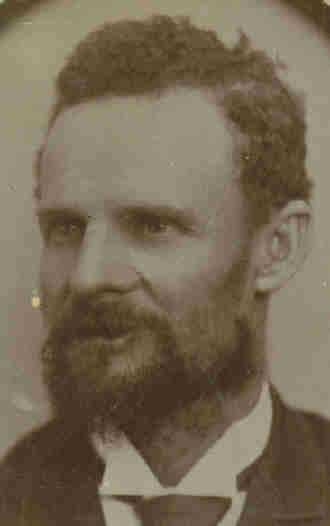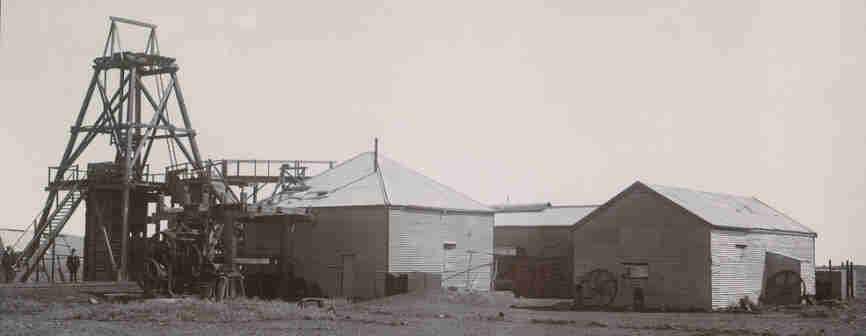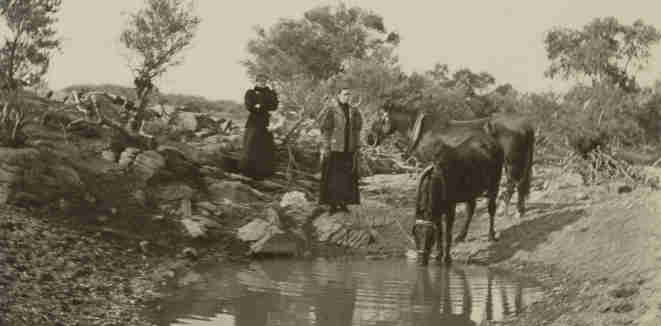


|


South Australia's Coal Mining Industry. |
 T Burgoyne 1900 (SLSA) |
It was during this time that the Commissioner of Crown Lands, Thomas Burgoyne, received an application for the 10,000 reward, originally offered in 1872, for the discovery of a viable coalfield. As he could not yet say if the discovery was bona fide he promised that 'the matter would be carefully enquired into'. By July a shaft just over fifty metres deep had been completed and timbered closely throughout. It was then decided that a horizontal drive, to mine the exposed coal seam, should be dug.
This job would be done by a competent mine manager from Newcastle, who brought five experienced coalminers with him. Further development of the property was to be carried out by John Beith, manager of the Queensland Deep-sinking Company, who contracted to put down a shaft of up to five hundred metres in less than twelve months. Within three months this shaft had already reached a depth of three hundred metres. During the company's half-yearly meeting, on 30 April 1891, shareholders were told that the bore had almost reached its depth and that they had also received a government subsidy of 500 to offset the cost of drilling. Naturally both confidence and speculation increased and within two weeks the Company's shares were worth four times their original value.
It was considered important enough for the treasurer, Tom Playford, to inform the Agent General in London about the Leigh Creek coal discoveries. As a result of all this positive news many people bought shares in the company, including E. Robertson from Moockra, who acquired five shares. After this initial success and publicity several new companies were formed, each hoping for the same, or even better results. Within a short time these companies, such as the Leigh's Creek South and the Leigh's Creek North mines, had taken out leases and commenced operations in the neighbourhood of Leigh's Creek. The management of the South Company in particular looked impressive with several of its directors, such as Sir J.U.C. Bray and W.E.B. Rounsevell, being parliamentarians. In June W.A. Kingsborough reported that the whole of the fifteen thousand shares in the South Company had been taken up.
The expansion of mining around Leigh's Creek and the subsequent inflow of visitors, workers and businesses, led to a different kind of investigation. This time it concerned the viability of connecting Leigh's Creek by rail, with the mineral country in the north east. This venture, it was stated, would prove of great benefit to the pastoralists and improve the viability of some of the copper mines in the area. The inquiry was carried out by the Queensland Border Railway Commission who, in October 1890, handed its final report to the House of Assembly in Adelaide. One of its recommendations was that the government should at once start with the building of a railway line from Leigh's Creek to Innamincka. The estimated cost of 322,000 would easily be recouped from future revenue, as it was bound to prove 'one of the best paying railway lines in the country'. Moving the Leigh's Creek railway platform closer to the mine and connecting it with telephone or telegraph services was also considered.
Early in August 1891 John Henry Reid, the original discoverer of the coal deposit, showed visitors from all over Australia around the mine. One of the parties was made up of D. Syme of the Melbourne Age, John Beith M.E. of Charters Towers and South Australia's government geologist Henry Brown, who later published a very detailed report on the field. After a lot of walking over the field they expressed much satisfaction and praised Reid for his efforts and persistence. During its chequered history the mine and coalfield would be visited by tens of thousands of people, including Governors, Prime Ministers, Premiers, members of parliament from both South Australia and the Commonwealth governments. Other visitors would be religious leaders, newspaper reporters, leaders of industry, union officials and many other interested people from all over Australia and even overseas.
When the coalfield was finally operating in the twentieth century it would also be visited by Geology and Engineering students from many Universities, thousands of school children and tourists every year. Reid would not have believed that one day, all these tourists, students and many other interested people would visit the coalfield and be shown around by trained guides in large air-conditioned buses. Nor would he have believed that a hundred years later one of his great-great grand daughters, Mrs E. Hegarty, would be living in Leigh Creek.
 WC Copley (SLSA) |
The Leigh's Creek Coal Mining Company appointed Ridley, selected from among 150 applicants, as its new site manager. Ridley soon appointed several miners and a Captain from Newcastle and arranged for two houses to be built for them as soon as possible. With so many people now living more or less permanently around the railway siding at Leigh's Creek, and a number of businesses established for several years, the government had a town surveyed in 1891. This was done by Edward Copley Playford, uncle of Sir Tom Playford who named it Copley, after William Copley, MP and Commissioner of Crown lands.
In March 1892, the first of many tests was carried out using Leigh Creek coal on steam trains. This most important trial was held on the Pichi Richi Line between Port Augusta and Quorn using a locomotive with one water tank, two brake-vans and twenty trucks. Many years later, when the Pichi Richi line had become a tourist attraction, Leigh Creek Management was approached by the operators to supply coal for their steam trains. Unfortunately, by that time it was uneconomical for Leigh Creek to supply them with coal.
After the first successful test, numerous other tests would follow during the next fifty years. One successful trial run, watched by Reid, was later made on the Adelaide-Glenelg Railway line. After the test the Leigh's Creek Coal Company called for tenders to sink a new shaft of at least one hundred metres. Specifications were displayed at Duck's Leigh's Creek store, Samuel Gason's Hotel in Beltana, William's store in Blinman and the Exchange Hotel in Farina. Notices were also displayed at Port Augusta, Moonta, Kadina, Broken Hill and at company's office in Adelaide. Twenty-eight tenders were interested and all were considered including those from Victoria and New South Wales. In the end it was the lowest tender from W.C. Martin & Co from Leigh's Creek which was accepted.
They started on 8 June 1892, about 350 metres South West from the first bore and shaft, (Lobe B) watched by Reid and many of the locals. When a depth of five feet was reached every one stopped for the official part of the job, the 'wetting' of the shaft. This was much appreciated by the men who drank in 'bumpers'. I. Hocart, of the local firm Duck and Hocart, christened the shaft 'Reid's Coal Shaft' after which he congratulated Reid for his persistence and wished every one good luck. Within a few days Reid was superintending the laying of the foundations for the engine and boiler.
Newspapers advised that those people who had bought shares in the Leigh's Creek mine would be fully justified 'in sticking like leeches to them for as sure as the sun shines the day will come when they will be rewarded'. Unfortunately for them, and South Australia as a whole, they were not rewarded. Even so, Gason's Hotel in Beltana kept the interest in coal alive. His hotel was visited not only by people who needed a drink or somewhere to stay the night, but many also came to see his Museum. This contained several petrified Mussel shells and samples of coal, shale and other interesting items of the Leigh Creek coalfield.
Many difficulties were encountered with the lower than usual quality coal and few industrial users were convinced that it was suitable for their plant. However coal was sold for private use, along the railway line, as far away as Adelaide, Farina, Beltana, Peterborough and Broken Hill. Some was processed in a briquetting machine but in almost all cases it was found to be unsuitable. The cost of transporting the briquettes to Adelaide increased the price of the product even more and made the whole venture uneconomical. During question time in parliament, Richard Foster still wanted to know if the Commissioner of Public Works would take steps to alter the fire bars in one of the locomotives so that fair tests might be conducted. This was promised by Holder, but two years later it was decided that the trials had not been considered sufficiently satisfactory to justify Leigh's Creek coal being used on the Northern Railway Line. The cost of transporting the coal to its different customers added even more to the many set-backs.
Hope of finding better quality coal, with a lower moisture content, was not abandoned. During the first week of August 1892 the coalfield was visited by the government geologist, the Inspector of Mines and Drew Williams, one of the company's directors. After several sites were studied, a new position was fixed for fresh boring activity, and the building of a manufacturing plant to produce briquettes for the Adelaide market was also proposed. In January 1893 it was decided to conduct further testing, this time it would be a comparative test between Leigh Creek coal and Newcastle coal to be held at Islington.
Even though stationary boilers were used, the Leigh Creek coal proved to be inferior. While these tests were in progress, further boring by the Leigh's Creek North Coal Mining Company had also been unsuccessful, and on 10 February 1893 it was decided to wind up that company. All was not bad news though. The Leigh's Creek South Coal Mining Company had received 95 in 1893, from a recently started government subsidy program, and was able to carry on with its work. Even more important was the work started by the South Australian government on the building of the Telford Railway siding to facilitate the loading of the coal.
 Telford 1894 |
Much development was completed during that year, and the year after. A badly needed dam, holding nearly twenty million litres, was dug and James Martin's Engineering Works of Gawler built and delivered a poppet head, pulley wheels, engine house and boiler. When all this equipment was installed, a briquetting machine was added, and within a short time everything was operating. The following year these briquettes were successfully used in locomotives operating on the Northern Line between Beltana and Farina.
During 1897 several more railway trials, extending over a period of eight weeks, were held with Leigh Creek coal. This time they were held between Port Augusta and Hergott Springs. During the whole of these trials every man worked very hard to make sure that the train would run on time and make the experiment a success, but the results were once again disappointing. Difficulties encountered this time were an increase in coal consumption, decrease in speed, especially uphill, and the emission of sparks. At times 'they were thrown up in showers' and, said the locomotive inspector, 'although small, they do not go out like sparks from Newcastle coal when they fall'. He concluded 'I can see no possibility of it being used with any success under existing conditions'.
At the Leigh's Creek Coal mine, where Captain Peter Neven had been in charge since 1896, work was still in progress. All that was needed were customers to buy the coal to keep production going. Mining at that time was carried out underground at two different levels, to which the miners descended in a steam powered kibble, controlled by Jack Carter. Captain Neven, who had gained experience in the Glasgow coal and iron mines, and held a first class certificate as a coalmine manager from the English government, was convinced that the coal was suitable for house coal, stationary engines and for smelting purposes.
 Leigh's Creek 1897 |
To prove its suitability for smelting purposes he had built a small smelter at the mine and successfully treated some ores from the surrounding copper mines. There were several other people who were convinced of the suitability of the Leigh Creek coal for this and other purposes. The coal had already been used successfully in the parlour of the Beltana Hotel to keep the customers warm on winter nights. In Port Augusta, Frank Montague, manager of the Honey and Company timber mill, had used the coal in his stationary boiler plant with good results.

***
If you would like to find out more,
![]()
![]()
please go
to home page for more information.
Thank you for visiting South Australian History,
We hope you enjoy your stay and find the information useful.
This site has been designed and is maintained by FRR.

